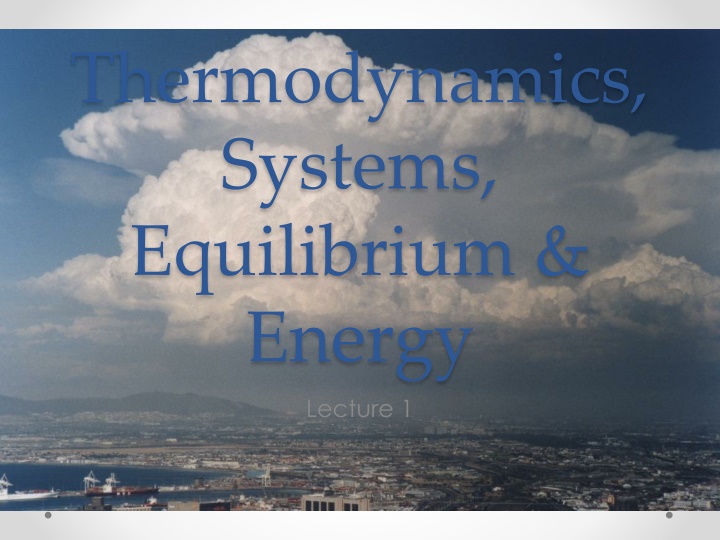
Thermodynamics and Energy Transformations in Geochemistry
This lecture introduces the fundamental concepts of thermodynamics, systems, equilibrium, and energy transformations in geochemistry. It covers the application of thermodynamics to predict equilibrium states, reactions, and mineral formation in geological processes. The course outlines the study of energy changes in chemical reactions and the interplay between thermodynamics and kinetics in understanding Earth's systems. Additionally, it discusses different types of systems in thermodynamics and their relevance in geochemical studies.
Download Presentation

Please find below an Image/Link to download the presentation.
The content on the website is provided AS IS for your information and personal use only. It may not be sold, licensed, or shared on other websites without obtaining consent from the author. If you encounter any issues during the download, it is possible that the publisher has removed the file from their server.
You are allowed to download the files provided on this website for personal or commercial use, subject to the condition that they are used lawfully. All files are the property of their respective owners.
The content on the website is provided AS IS for your information and personal use only. It may not be sold, licensed, or shared on other websites without obtaining consent from the author.
E N D
Presentation Transcript
Thermodynamics, Systems, Equilibrium & Energy Lecture 1
Plan of the Course The Geochemical Toolbox o Thermodynamics o Kinetics o Aquatic systems o Trace elements & magmatic systems o Isotopes Radiogenic Stable The Big Picture: Cosmochemistry o Formation of the elements o Formation of the Earth and the Solar System Chemistry of the Earth
Other Info Grading: 40% Problem Sets (6 to 8),20% Prelim, 40% Final Exam http://www.geo.cornell .edu/geology/classes/ geo455/EAS455.html Office: 4112 Snee Office Hours: no formal office hours drop by anytime. Text: White: Geochemistry, Wiley-Blackwell, ISBN 978-0-470-65668-6
Thermodynamics Thermodynamics is the study of energy & its transformations. o Chemical changes involve energy; by following the energy , we can predict the equilibrium state of a system and therefore the outcome of reactions. For example, we can predict the minerals that will crystallize from a cooling magma. We can predict that as the concentration of atmospheric CO2 increases, so does that of the ocean and the calcium carbonate shells of oysters and skeletons of corals will become more soluble. o (This at first seems counter-intuitive, and has to do with a decrease in ocean pH). Thermodynamics uses a macroscopic approach. o We can use it without knowledge of atoms or molecules. o We will occasionally consider the microscopic viewpoint using statistical mechanics when our understanding can be enhanced by doing so.
Thermodynamics and Kinetics The equilibrium state of a system is independent of any previous state. So, for example, if we do a partial melting experiment with rock, it should not matter if we start with a solid and partially melt it or with a melt and partially crystallize it, or whether we partially dissolve calcium carbonate or partially precipitate it. Kinetics is the study of rates and mechanisms of reaction. Kinetics concerns itself with the pathway to equilibrium; thermodynamics does not. Very often, equilibrium in the Earth is not achieved, or achieved only very slowly, which naturally limits the usefulness of thermodynamics.
The System Four Kinds of Systems A thermodynamic system is the part of the universe we are considering. Everything else is referred to as the surroundings. o We are free to define the system anyway we chose. However, how we define it may determine whether we can successfully apply thermodynamics.
Equilibrium The equilibrium state is the one toward which a system will change in the absence of constraints. It is time invariant on the macroscopic scale, but not necessarily on the microscopic one.
Equilibrium & Thermodynamics Conundrum: strictly speaking, we can apply thermodynamics only to the equilibrium state. If a reaction is proceeding, then the system is out of equilibrium and thermodynamic analysis cannot be applied! Solution: we imagine reversible processes in which systems are only infinitesimally out of equilibrium. In contrast, natural processes can proceed only in one direction and are irreversible. We might also imagine local equilibrium where even if the whole system (e.g. the ocean or magma and crystals) is out of equilibrium, we can imagine a part of it is in equilibrium (rim of the crystal).
Fundamental Variables Pressure: P o Force/unit area Volume; V Temperature: T Energy: U o Work: W we are mainly concerned with P-V work: pressure integrated over volume change Work done by a system is negative o Heat: Q Entropy: S more on that in next lecture
Work, Heat, and Energy Work is done by moving a mass, M, over some distance against a force (eg., gravity) X w - Fdx 0 F = Mdv o Where dt o Note that the minus sign occurs because work done by a system is negative, work done on a system is positive. Heat is thermal energy that results from collective random motion of atoms or molecules in a system (including rotational and vibrational motions); related to kinetic energy, particularly with respect to translational motions of molecules in a gas.
System International (S.I.) Units Pressure: Pascals, Pa ( Newton/m2 = kg-sec2/m) o Other: atmospheres ~ bars 0.1 MPa Volume: m3 o Other: cm3, liter 1m3 = 106 = 103 l o (note: liter is the standard unit in aquatic chemistry) Temperature: Kelvins (K) o Other; C; 1K = 1 C, 0 C = 273.16 K Energy: Joules, J (kg-m2/sec2) o Other: calories 1J = 4.184 cal. Entropy: J/K Mass: mole, N (also mol); amount, in grams, of an element equal to its atomic weight (e.g., 1 mol C = 12g or 0.012 kg).
Extensive vs. Intensive variables Extensive variables are ones that depend on the mass of the system, intensive ones do not. Which of the following are extensive? Pressure Volume Temperature Energy Work Heat Moles We can convert extensive variables to intensive ones by dividing on extensive variable by another. o Molar volume: V =V /N Density: V/M
State Variables and Equations of State State variables depend only on the state of the system, not on the path taken. Not all the variables listed above are state variables. Equations of state express the relationship between state variables, e.g. PV=NRT o Tells us, for a given number of moles, now temperature, volume, and pressure of an ideal gas relate to each other; i.e., if we heat the gas, what happens to volume and pressure?
Ideal Gas Law PV = NRT Ideal gas law grew out of Boyle s (1627-1691) experiments with gases and was formalized by mile Clapeyron in 1834. o Fine as an approximation, but doesn t work with real gases. An ideal gas is one in which: o The molecules occupy no volume o The only interactions between molecules are elastic collisions. o When might a gas most behave ideally? Van der Waals Equation P =RT V -b-a V2 The b term corrects for the finite volume of molecules while the a term corrects for their interactions. This is still often a poor approximation to the behavior of real gases. Two geochemically important gases, water vapor and CO2 show particularly complex P- T-V behavior. R: Gas constant: simply converts units. (We ll see it is the molar equivalent of Boltzmann s constant, which has atomic units). o o
General Equation of State Obviously, there is no one solution to the ideal gas law, but we can imagine a couple of special cases: Hold pressure constant o Isothermal compressibility ( ): change in volume with change in pressure at constant temperature per unit volume: -1/V( V/ P)T Hold temperature constant o Coefficient of thermal expansion ( ): change in volume with change in temperature at constant pressureper unit volume 1/V( V/ T)P. We can write a general equation relating V, T & P: dV = V/ T)PdT + ( V/ P)TdP dV = V dT + V dP o These equations are general and apply to all substances. The difference is that and have simple solutions for ideal gases (NR/P and 1/T, respectively), while they are more complex functions for real substances.
Temperature Temperature is a measure of the average internal kinetic energy of a system. How do we measure it? o Since the volume of an ideal gas is a simple function of T at constant P, we can use it to construct a thermometer. o We can arbitrarily define a scale such that V = V0(1+ ) o Where is our measure of temperature. If so, we might have negative . o But note V cannot be negative, so there must be a minimum value of : an absolute minimum to temperature. o The absolute minimum of T occurs where the volume of an ideal gas is 0. Use the absolute scale (K) in all thermodynamic calculations.
Zeroth Law Two bodies in thermal equilibrium have the same temperature. Two bodies in equilibrium with a third body are in equilibrium with each other.
The Three Es Energy, Entropy and Enthalpy
The First Law Statements: o Energy is conserved in all transformations o Heat and work are equivalent (the sum of the two is always the same). o Change in energy of a system is independent of the path taken. Mathematically: U = Q +W The First Law implies that energy change is path independent and thus that energy is a state variable. Heat and work are not. State variables have exact differentials (heat and work do not). o (we are mainly concerned with energy changes, not absolute amounts). (Of course, the First Law ultimately fails because energy can be created out of mass. This turns out to be important because this energy source powers not only the Sun (and hence many processes at the surface of the Earth), it also powers, in part, the Earth s interior and geologic processes such as plate tectonics. That need not concern us until much later in the course.)
State Functions & Path Independence State functions are path independent and have exact differentials. Think about an internal combustion engine. Chemical energy is released by burning gas. Some of that energy goes into heat and some to work. There is no fixed rule about how much goes to each it depends on your engine design (engineers work to increase the amount going into work). Therefore, heat and work cannot be state functions. However, no matter how you design the engine, the sum of heat and work for a given amount of (fully) combusted gasoline is the same. Energy is path independent and a state function.
State Functions & Exact Differentials State functions have exact differentials. o (These are not new, they are the kind you have learned about in calculus). o This means we can obtain (in principle anyway) an exact solution if we differentiate them (or integrate the differentials). Exact differentials have the property that the cross differentials are equal (in other words, if we differentiate by two separate variables, the order doesn t matter). o Again, this is what you learn in calculus. Consider dV = ( V/ T)PdT + ( V/ P)TdP If V is a state function, then ( V2/ T P)= ( V2/ P T) This is not true of non-state functions like work and heat.
Work Is Work done by an ideal gas a state function? o Work is: dW = -PdV o Expanding the dV term, we have P T dW =-P V dT + V dP T P Substituting for ( V/ T)P and ( V/ P)T dW =-NRdT +NRT dP P NR P (NRT /P) T

